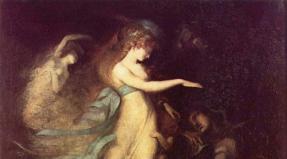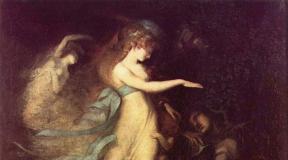Pygmalion and Galatea. Pygmalion and Galatea Who made Galatea
Jean-Léon Gérôme. Pygmalion and Galatea 1890
Sculptor.

Jean-Leon Gerome. Pygmalion and Galatea 1890
Evgeny Baratynsky.
Aphrodite gives happiness to those who serve her faithfully. So she gave happiness to Pygmalion, the great Cypriot artist. Pygmalion hated women and lived in solitude, avoiding marriage.

François Boucher. Pygmalion and Galatea 1767
One day he made a statue of a girl of extraordinary beauty from shiny white ivory. This statue stood as if alive in the artist’s studio. It seemed that she was breathing, it seemed that she was about to move, walk and speak. The artist spent hours admiring his work and finally fell in love with the statue he himself had created. He gave her precious necklaces, wrists and earrings, dressed her in luxurious clothes, and decorated her head with wreaths of flowers. As Pygmalion often whispered:
- Oh, if you were alive, if you could respond to my speeches, oh, how happy I would be!
But the statue was silent.

Jean-Baptiste Regnault 1786
The days of celebration in honor of Aphrodite have arrived. Pygmalion sacrificed a white heifer with gilded horns to the goddess of love; he stretched out his hands to the goddess and whispered prayerfully:
- Oh, eternal gods and you, golden Aphrodite! If you can give everything to the one who asks, then give me a wife as beautiful as that statue of a girl that I made myself.
Pygmalion did not dare to ask the gods to revive his statue; he was afraid of angering the Olympian gods with such a request. The sacrificial flame flared up brightly in front of the image of the goddess of love Aphrodite; By this, the goddess seemed to make it clear to Pygmalion that the gods had heard his prayer.

The Godhead Fires - Edward Burne-Jonest 1878
The artist returned home. He approached the statue, and, oh, happiness, oh, joy: the statue came to life! Her heart is beating, life is shining in her eyes. So the goddess Aphrodite gave a beautiful wife to Pygmalion.

Jean Raoux (1677–1734). Pygmalion adoring his statue 1717
Poems to Galatea
Leave Pygmalion, Galatea...
Like a mania, obsessed with talent,
The marble is numb beyond the clouds,
To the earthly he becomes a stranger.
He again hides his dreams in a cold block,
As if he hopes again
Experience God-given luck -
Love from inspiration to create...

Pygmalion et Galatée, Anne-Louis Girodet-Trioson 1819
No one else will resurrect you!
© 07.07.2011 Hermit

Bronzino - Pygmalion and Galatea (1529-30)
Another legend:
The most beautiful legend about the sculptor, glorifying his extraordinary gift, is dedicated to a Cypriot sculptor named Pygmalion. This talented man was so passionate about his work that he did not find time to get married.

Ernest Normand 1886
One day Pygmalion decided to sculpt the figure of a girl that his imagination had drawn. For many days and nights he did not leave the workshop, as if he was really in a hurry to free the girl from the captivity of his fantasies. The statue came out amazingly well. The young beauty stood in the middle of the workshop and seemed to smile slightly at her creator. The sculptor named her Galatea. The master was sure that the goddess of love Aphrodite herself was guiding his hand.

François Lemoyne. Pygmalion Seeing His Statue Come to Life 1729
When the time came for the holidays in honor of the great goddess, Pygmalion decided to ask her for happiness. At sunset, he approached her statue in the temple, knelt before her and said: “O great goddess of love, beautiful Aphrodite! It was not in vain that you lit a fire in my heart and gave me the strength to carve in your honor a girl whose beauty can decorate the world. I ask you, revive her, and she will be the most beloved and desired woman for me.” It seemed to Pygmalion that the goddess’s face lit up with a smile.

Laurent Pécheux (1729–1821) Pygmalion and Galatea
In joyful anticipation, he returned home, buying expensive clothes, bracelets and other jewelry as a gift to Galatea. On the threshold of the house he was met by his living lover. The gods appreciated the sculptor’s talent and gave him the constellation Sculptor.

Constellation Sculptor Southern Hemisphere of the starry sky
Greek legend says:
Aphrodite patronized everyone whose love was strong and constant. An example of Cypris's exceptional favor towards one of her lovers is the story that happened with the king of Cyprus, the young Pygmalion, skilled in sculpting.

Louis Jean François Lagrenée (1724 - 1805) Pygmalion and Galatea
Once Pygmalion managed to carve a statue of a young woman of amazing beauty from precious ivory. The more often Pygmalion admired his creation, the more merit he found in it. It began to seem to him that not a single mortal woman surpassed his statue in beauty and nobility. Jealous of everyone who might see her, Pygmalion did not allow anyone into the workshop. Alone - during the day in the rays of Helios, at night by the light of lamps - the young king admired the statue, whispered tender words to it, and presented it with flowers and jewelry, as lovers do. He named her Galatea, dressed her in purple and seated her next to him on the throne.

Louis Gauffier. Pygmalion and Galatea (1797)
During the festival of Aphrodite, celebrated by all the islanders, Pygmalion in the out-of-town sanctuary of the goddess made sacrifices to her with the prayer:
- Oh, if only I had a wife like my creation.
The goddess heard many fervent prayers on her day, but she condescended to Pygmalion alone, for she knew that there was no person in all of Cyprus who loved as ardently and sincerely as Pygmalion. And the sacrificial fire flashed three times in the altar as a sign that Aphrodite heard Pygmalion and heeded his plea.

Giulio Bargellini (1875-1936) Pygmalion and Galatea 1896
Unable to feel his feet under him, the king rushed to the palace. And here he is in the workshop, next to his hand-made lover.
- Well, why are you still sleeping? - he turned to her with a gentle reproach. - Open your eyes, and you will see that Helios’s solar chariot has already risen, and he will tell you the good news.
The rays fell on the ivory face, and it seemed to Pygmalion that it turned a little pink. Grabbing his girlfriend by the hand, he felt that the bone was yielding to the pressure of his fingers, he saw that the skin on her face was becoming whiter and a blush appeared on her cheeks. The chest expanded, filling with air. And Pygmalion heard the calm and even breathing of the sleeping woman. The eyelids lifted, and the eyes flashed with that dazzling blue of the sea that washes the island of Aphrodite.

Edward Burne-Jones

Edward Burne-Jones, 1867
The news that the bone was revived by the power of love and that not the elephant to whom it belonged, but a beautiful maiden was born, spread throughout the entire island in a short time. Huge crowds flocked to the square in front of the palace, happy Pygmalion was no longer afraid of envious glances and gossip. He brought out the newborn, and, seeing her beauty, people fell to their knees and loudly praised the Lady Aphrodite, who gives love to everything that lives, and who can revive stone and bone in the name of love and for love.

Godfried Schalken Or Schalcken. Pygmalion and Galatea
Immediately, in front of everyone, Pygmalion proclaimed the girl the queen of Cyprus and covered her fragrant hair with a royal crown. In a purple robe, her face beaming with newfound happiness, she was as beautiful as Aphrodite herself.
For those who are completely unaware of what we are about to talk about, let us explain that an attempt will be made to briefly outline the plot not of the ancient myth about the sculptor Pygmalion, who fell in love with the beautiful statue of Galatea he created and begged the gods to revive it, but of the plays of the great English playwright
Let's get started... Act one
The full title of the play is: “Pygmalion: a fantasy novel in five acts.”
Not everyone can sight-read plays, and there aren’t many avid theatergoers left anymore. The world is ruled by the Internet and television. Of course, Shaw's works have been filmed more than once, and counting the number of productions is completely hopeless. But watching a film takes hours, reading the text of a play is also not a quick task, and for those who want to save time and get an education, they came up with a summary.
“Pygmalion” - in the following text, for the sake of brevity, this is what we will call this play - begins with rain. Yes, an ordinary summer downpour, which caught almost all the characters in the work. They stand under the portico of St. Paul's Cathedral and wait for a taxi. Mobile phones had not yet been invented, taxi services did not work on such a scale as they do today, and in order for everyone to get home more or less dry, someone had to sacrifice themselves. Who is this lonely hero? Naturally, the youngest and most trouble-free Freddie. But even after getting completely wet during the search, he does not find a taxi, for which he receives a full reprimand from his mother and sister. While rushing to take cover under the portico, Freddie brushes against a poorly dressed girl with a basket of flowers. She doesn’t stand to lose, and with the frankness characteristic of commoners, she expresses everything she thinks about clumsy young people in general and Freddie in particular. Having heard such interesting and in some way poetic epithets, a gentleman standing a little to the side hastily begins to write something down on a laptop (a laptop used to be called ordinary notebooks - notepads).

The girl takes the logical step and begins to advertise her product. In particular, he begs the colonel standing next to him to purchase several violets and thereby support commerce. The colonel takes out some change and pays off the clever trader, but on principle does not take a bouquet of violets. Then someone notices a gentleman enthusiastically taking shorthand notes and suggests that he is composing a denunciation to the KGB (in Great Britain, of course, there is no KGB, but there is Scotland Yard). There is a general wave of indignation against police brutality. To avoid being lynched on the spot, the gentleman with the notebook very cleverly guesses the birthplace of some of the accusers. He gets away with it quite well, but the people demand immediate exposure of the black magic session.
Everything turns out to be quite innocent, and instead of a secret service agent, the public now sees before them a harmless linguist. Poor Freddie is not allowed to watch the show to the end and is again pushed out into the rain, with instructions not to return without a taxi. While Freddie is wandering around London looking for a car, the rain suddenly stops, and his relatives decide that they can do without a taxi. The people are slowly dissolving, and as a result only three main characters remain:

flower girl linguist-magician Professor Higgins and Colonel Pickering. The last two find out that they had long dreamed of meeting each other, but it never worked out, and if it weren’t for the blessed rain, they would have been chasing each other, either in India or in England. After reprimanding Eliza for not doing well at school, not being able to speak at all like educated white colonialists, and noting that she would do well to attend a course in noble manners, they exchange their addresses, donate a bunch of change to the violet seller and walk away.
Somehow the first act turned out to be too drawn out, and looked like anything but a summary. Pygmalion consists of five acts. And at this rate we won’t get to the end of the play soon. Moreover, it is completely unclear what the antique sculptor has to do with it. Let's hope that this will become clear further and continue to present our summary.
"Pygmalion", act two
It begins in Professor Higgins' apartment. Our linguist boasts to the colonel about his recording equipment, the latter expresses immoderate admiration for the quality and purity of the sound. Their conversation is interrupted by a visit from... who do you think? You'll never guess - Eliza Dolittle herself! She came to hire Higgins as a tutor in penmanship and staging. She remembered the address yesterday, but the money given to her by two friends, as she herself believes, is quite enough to buy and receive it as a load for the delivery of the Tower.

But the professor categorically claims that he is not involved in tutoring. However, having learned a lot of new and interesting things about himself and the colonel from Eliza, he suddenly decides to make her not just anyone, but a real duchess. And he even refuses to charge for it. However, he is not so unmercenary, and makes a bet for a large sum with the colonel that he will cope with this difficult task in just a few months. No, we are not talking about this at all. In the play “Pygmalion”, a summary of which you are now reading, there is no criminality at all. This is not a detective story or a thriller. The essence of the bet is that at the end of the training, Eliza is brought to a reception at the embassy, introduced not as a flower girl, but as a duchess, and waits to see if their deception will be revealed. While the professor's housekeeper is subjecting Miss Dolittle to cruel hygiene procedures, the girl's father comes to Higgins' apartment. He turns out to be a scavenger, battered by life, but with philosophical problems and problems in his family life. He expresses fear for the safety of the innocence of his only and beloved daughter, but for five pounds he agrees to strangle his fatherly feelings.
Pygmalion" Show: a summary of the subsequent third and fourth acts
The professor mercilessly pushes the unfortunate girl through the grammar and syntax of the English language, simultaneously teaching her to behave with high society tact.
After some time, considering Eliza to be quite “savvy”, Higgins decides to give her a mini-exam and brings her to her mother for training. There, by a strange coincidence, the same mother of unfortunate Freddie turns out to be. Naturally, the young man begins to show Eliza signs of attention, which cannot but please both his own mother and the professor himself. And the professor’s mother unexpectedly likes the girl.
The bet comes to an end, and Eliza brilliantly plays the role of the duchess at the reception. Tired of the hassle, the debaters are glad that it’s all over, congratulate each other on a job well done and go to their rooms. It never occurs to them to thank Eliza, since for them she is not a person, but a tool. Eliza, having spent a lot of energy and a lot of nerve cells at the reception, is deeply offended by such a dismissive attitude towards her and throws a pair of shoes at the smug professor.
Fifth - final act
The girl runs away from these two "blockheads in suits." The next morning, not finding their usual toy at the threshold of the bedroom with slippers in their teeth, Pickering and Higgins run to complain to the latter’s mother, indignant at the ungrateful girl. And imagine their surprise when, instead of the expected sympathy, they receive a sharp rebuke. It turns out that Eliza came to Mrs. Higgins at night and poured out her resentment towards the gentlemen for half the night.
The play is rapidly moving towards the finale, and our summary is also heading there. Pygmalion doesn't end with the ringing of wedding bells, as you might have hoped. Not at all. Both Professor Higgins and Colonel Pickering are not romantic heroes; they are not at all passionately in love with the young violet seller. They just got used to her, and now they don’t want to exist separately from Eliza. They express all this to Eliza herself and the professor’s mother. This is where the play ends, leaving the reader slightly perplexed about how the future fate of the characters will develop. A curtain.
Pierre Firens. Pygmalion Les Propetides. 1561.
Workshop of Michael and Philip Wauters, Design by Daniel Janssens. Pygmalion and Galatea. 1680.
Johann Wilhelm Baur. Pygmalionis effigies eburnea in hominen mutatur. 1703.
François Lemoyne (1688–1737). Pygmalion Seeing His Statue Come to Life. 1729.
Louis Carrogis (1717-1806). Monsieur Messer et Madame Boissier, deux amateurs jouant dans Pygmalion.
Pygmalion & Galatee by Étienne Maurice Falconet. 1763.
François Boucher (1703–1770). Pygmalion and Galatea. 1767.
Antoine Francois Dennel (original painting Louis Lagrenee). Pygmalion. 1778.
Noël Le Mire nach Moreau le Jeune. Pygmalion. 1778.
Louis Jean François Lagrenée (1724 - 1805). Pygmalion and Galatea. 1781.
Laurent Pecheux. Pygmalion and Galatea. 1784.
Château de Versailles, salon des nobles, Pygmalion priant Venus d'animer sa statue, Jean-Baptiste Regnault. 1786.
Louis Gauffier (1762–1801). Pygmalion and Galatea. 1797.
Henry Howard (1769 - 1847). Love animating the statue of Pygmalion. 1802.
Anne-Louis Girodet-Trioson. Pygmalion et Galatee, 1819.
The Marble Maiden. 1845, after a lithograph by J. Brandard.
Pygmalion and the Image I The Heart Desires. Edward Burne-Jones. 1875-1878.
Pygmalion and the Image II The Hand Refrains. Edward Burne-Jones. 1875-1878.
Pygmalion and the Image III The Godhead Fires. Edward Burne-Jones. 1875-1878.
Pygmalion and the Image IV The Soul Attains. Edward Burne-Jones. 1875-1878.
Ernest Normand. Pygmalion and Galatea. 1886.
Pygmalion and Galatea. Giulio Bargellini. 1896.
Pygmalion and Galatea by Jean-Léon Gérôme.
Pygmalion and Galatea. Jean-Leon Gerome (1824 - 1904).
Franz von Stuck (1863 - 1928). Pygmalion.
Herbert Schmalz (1856-1935) - L"Eveil de Galatée.
Lucilio de Albuquerque - Pigmaleão e Galatéia, 1905.
Pygmalion (Greek: Πυγμαλίων) is a sculptor in Greek mythology who created a beautiful ivory statue and fell in love with his creation.
Pygmalion was the king of the island of Cyprus, the son of Bel and Ankhinoe. He carved an ivory statue and fell in love with it. He gave her gifts, dressed her in expensive clothes, but the statue continued to remain a statue, and unrequited love. During a holiday dedicated to Aphrodite, Pygmalion turned to the goddess with a prayer to give him a wife as beautiful as the sculpture he made. Pygmalion did not dare to ask to revive the cold statue. Touched by such love, Aphrodite revived the statue, which became Pygmalion's wife. This myth may have been introduced into literature by Neanthes of Cyzicus. The golden Pygmalion olive was kept in Gadir.
According to one version, the wife gave birth to Pygmalion’s sons Paphos, Kinira and daughter Metarmus. According to Ovid, Kinir was the son of Paphos. There is also a known version according to which Pathos is not the son, but the daughter of Pygmalion.
The name of Pygmalion's wife - Galatea - is not mentioned in ancient sources and was invented in 1762 in Rousseau's work "Pygmalion". The name became a household name, and the myth became a frequent subject in art.
Aphrodite patronized everyone whose love was strong and constant
Once upon a time, an amazing Master lived in Cyprus - the sculptor Pygmalion (according to another version, he was also a king).
He sculpted such beautiful women that it was breathtaking to look at them. Pygmalion's talent was known far beyond the borders of Cyprus. The Master had no end to orders, and he was rich and lived in honor. No one could have guessed how much the brilliant sculptor hated women. He considered them empty and talkative creatures, and he was always bored with them. Therefore, Pygmalion lived in solitude.
Many beauties dreamed of marrying him, but the Master did not allow anyone to approach him, he had no intention of getting married.
Once Pygmalion managed to carve a statue of a young woman of amazing beauty from precious ivory.
When he finished his work and looked at her, he shuddered in surprise: she looked at him as if alive. That night Pygmalion could not fall asleep for a long time, thinking about life and his loneliness. And the next morning, sitting down to work, he put the girl’s figurine next to him and began to tell her about his life.
She was silent and seemed to listen carefully. And Pygmalion suddenly felt an extraordinary excitement: he wanted the girl to answer something. But she was silent... Every day Pygmalion told more and more about himself to the fragile figure looking at him with attentive eyes, and every day he felt that longing was beginning to grow in him. He wanted to HEAR her, he wanted her to answer him, and not be silent.
And he also felt a hitherto unfamiliar feeling, something he had never experienced before. It was love.
“Come to life!” Pygmalion whispered at night, “answer me something!”
But Galatea, the name he gave to the lovely ivory girl, remained silent...
During the festival of Aphrodite, celebrated by all the islanders, Pygmalion in the out-of-town sanctuary of the goddess made sacrifices to her with the prayer:
- Oh, if only I had a wife like my creation.
The goddess heard many fervent prayers on her day, but she condescended to Pygmalion alone, for she knew that there was no person in all of Cyprus who loved as ardently and sincerely as Pygmalion. And the sacrificial fire flashed three times in the altar as a sign that Aphrodite heard Pygmalion and heeded his plea.
Pygmaleon rushed into the workshop.
The first rays of the sun fell on the sculpture of a girl. And at that very second Galatea’s eyes warmed, her heart began to beat, and she came to life. Galatea looked at her creator with such tenderness and with such trust that he choked with happiness and silently pressed her to him.
The news that the bone was revived by the power of love and that not the elephant to whom it belonged, but a beautiful maiden was born, spread throughout the entire island in a short time. Huge crowds flocked to the workshop.
Happy Pygmalion brought Galatea out, and, seeing her beauty, people fell to their knees and loudly praised the Lady Aphrodite, who gives love to everything that lives, and who can revive stone and bone in the name of love and for love.
Pygmalion and Galatea lived happily ever after and loved each other until their death.
The sculptor never offended his beloved wife with a word or a look, and she, in turn, carefully took care of him and did not notice anyone around. she became his assistant, friend and attentive wife. Until the end of his days, Pygmalion thanked the goddess Aphrodite and his hands that created Galatea...
According to legend, Pygmalion was not only the ruler of the island of Cyprus, but also a talented sculptor. One day he carved a statue of a beautiful girl from precious ivory. She seemed so attractive to him that she eclipsed all real women. Pygmalion gave his beloved expensive gifts and dressed her in beautiful outfits, but the statue continued to remain cold and insensitive. Famous psychologist Annetta Orlova explained why people tend to create ideal images of their loved ones.
“Each of us develops a certain understanding of what kind of partner should be next to us. And naturally we endow him with certain characteristics, we dream about something... And, based on all these experiences and all these criteria, we gradually form this ideal image of a partner. And he can be endowed with such contradictory qualities that are almost impossible to find in one person in real life. And then this ideal becomes seemingly unattainable.”
According to mythology, all ancient Greeks celebrated holidays dedicated to their gods. And so, on the day of the Goddess of Love Aphrodite, King Pygmalion turned to his patroness with a prayer. He did not dare ask the goddess to revive the statue and only hoped that Aphrodite would help him find a wife as beautiful as this creation. The sincerity and strength of Pygmalion’s feelings touched the goddess. She fulfilled the king’s request in the best possible way. After a while, the statue’s cheeks turned red, and the loving sculptor heard quiet, even breathing. So the dream came true. The lead singer of the Reflex group, Irina Nelson, is sure that such love is possible in reality.
“In our case, this is what happened with Vyacheslav, because when we started working together, we stopped finding the difference between where we are a producer and a singer, and where we are already closer people. We fell in love with the product that we made together, and it was already our brainchild. We sculpted each other, as a matter of fact.”
It is known that in the original version of the myth, the revived statue of Pygmalion did not have a name. The Queen of Cyprus was first called Galatea by the eighteenth-century French writer Jean-Jacques Rousseau. The name became a household name, and the myth itself was taken as the basis for many works of art. This is how, for example, the brilliant work of playwright Bernard Shaw “Pygmalion” was born. The famous artist Nikas Safronov shared his observations.
“We have seen a huge number of replicas on this theme by artists of both the Renaissance and modern artists of the 19th and 20th centuries. Everything is dedicated to this Galatea, where she is always depicted sublimely, beautifully, elegantly, desirable, etc.”
Nikas himself was also involved in creating a variation on the theme of this famous myth. He created paintings for the production of the play “Pygmalion” at the Armen Dzhigarkhanyan Theater, which appear on stage in the form of conventional, visual walls.
“The performance was interesting, and it was a pleasure to work with him, with Armen Borisovich Dzhigarkhanyan. In Bernard Shaw's Pygmalion, she learns all the manners that the main character tries to instill in her. The colonel appears as if in the image of Aphrodite, who gives an opportunity, a chance to resolve the situation in this direction.”
Thus, the mythical characters Pygmalion and Galatea immortalized their history and proved to the whole world that love, familiar to us from myths and legends, may well become a reality. True feelings make people better, kinder, and can even turn a stone into a beautiful person.


















